2022 HYUNDAI KONA turn signal
[x] Cancel search: turn signalPage 15 of 579
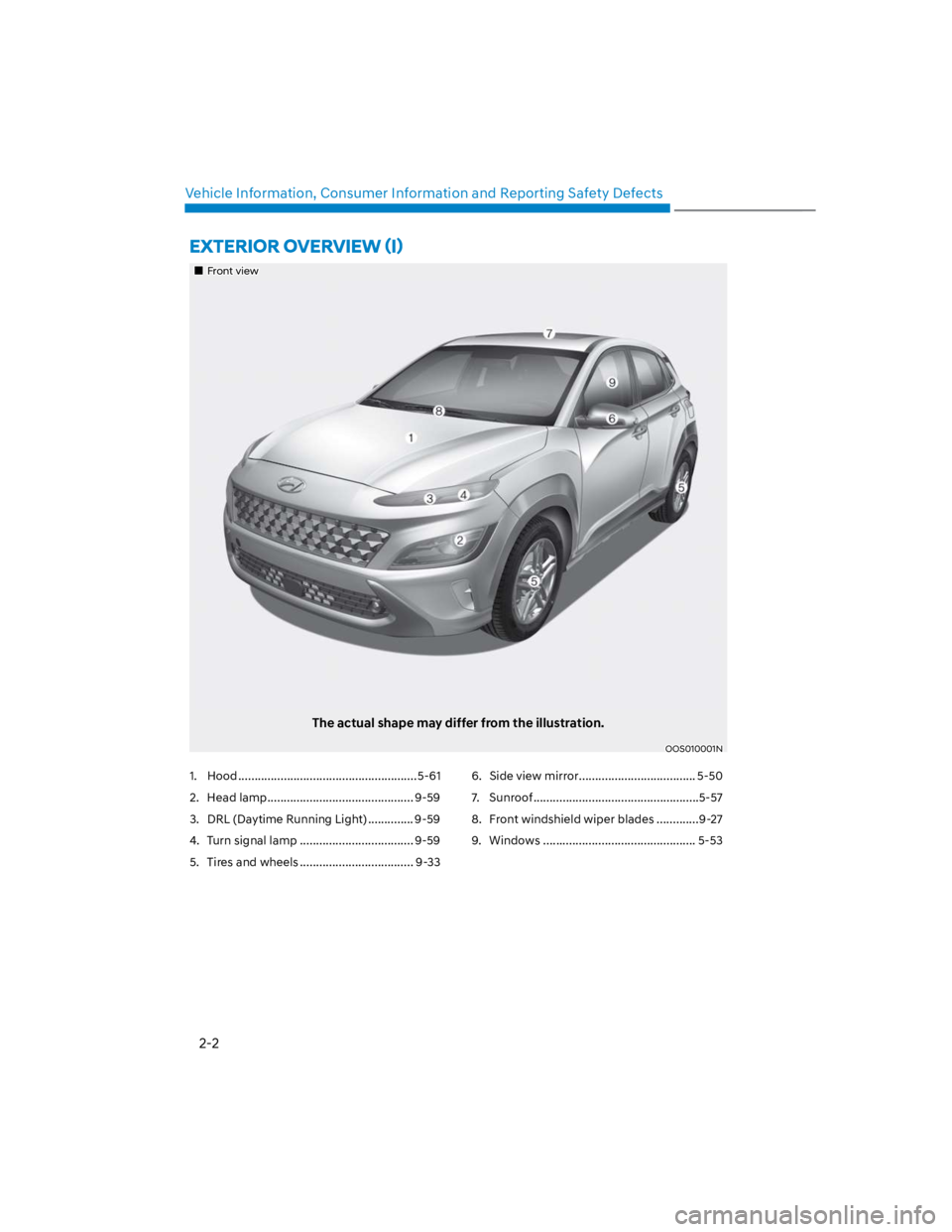
2-2
Vehicle Information, Consumer Information and Reporting Safety Defects
Front view
The actual shape may differ from the illustration.
OOS010001N
1. Hood ....................................................... 5-61
2. Head lamp ............................................. 9-59
3. DRL (Daytime Running Light) .............. 9-59
4. Turn signal lamp ................................... 9-59
5. Tires and wheels ................................... 9-33
6. Side view mirror .................................... 5-50
7. Sunroof ...................................................5-57
8. Front windshield wiper blades .............9-27
9. Windows ............................................... 5-53
Page 16 of 579
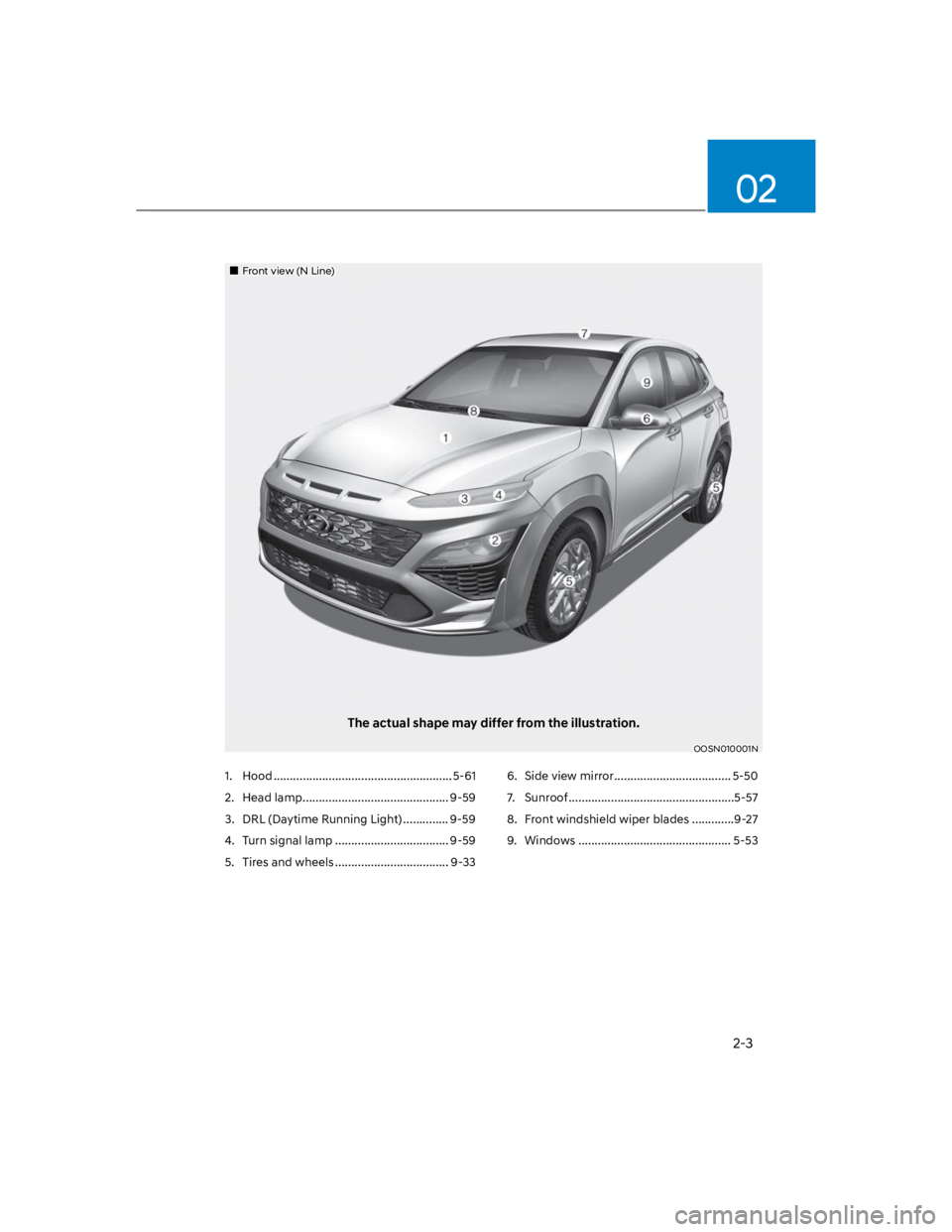
2-3
02
Front view (N Line)
The actual shape may differ from the illustration.
OOSN010001N
1. Hood ....................................................... 5-61
2. Head lamp ............................................. 9-59
3. DRL (Daytime Running Light) .............. 9-59
4. Turn signal lamp ................................... 9-59
5. Tires and wheels ................................... 9-33
6. Side view mirror .................................... 5-50
7. Sunroof ...................................................5-57
8. Front windshield wiper blades .............9-27
9. Windows ............................................... 5-53
Page 17 of 579
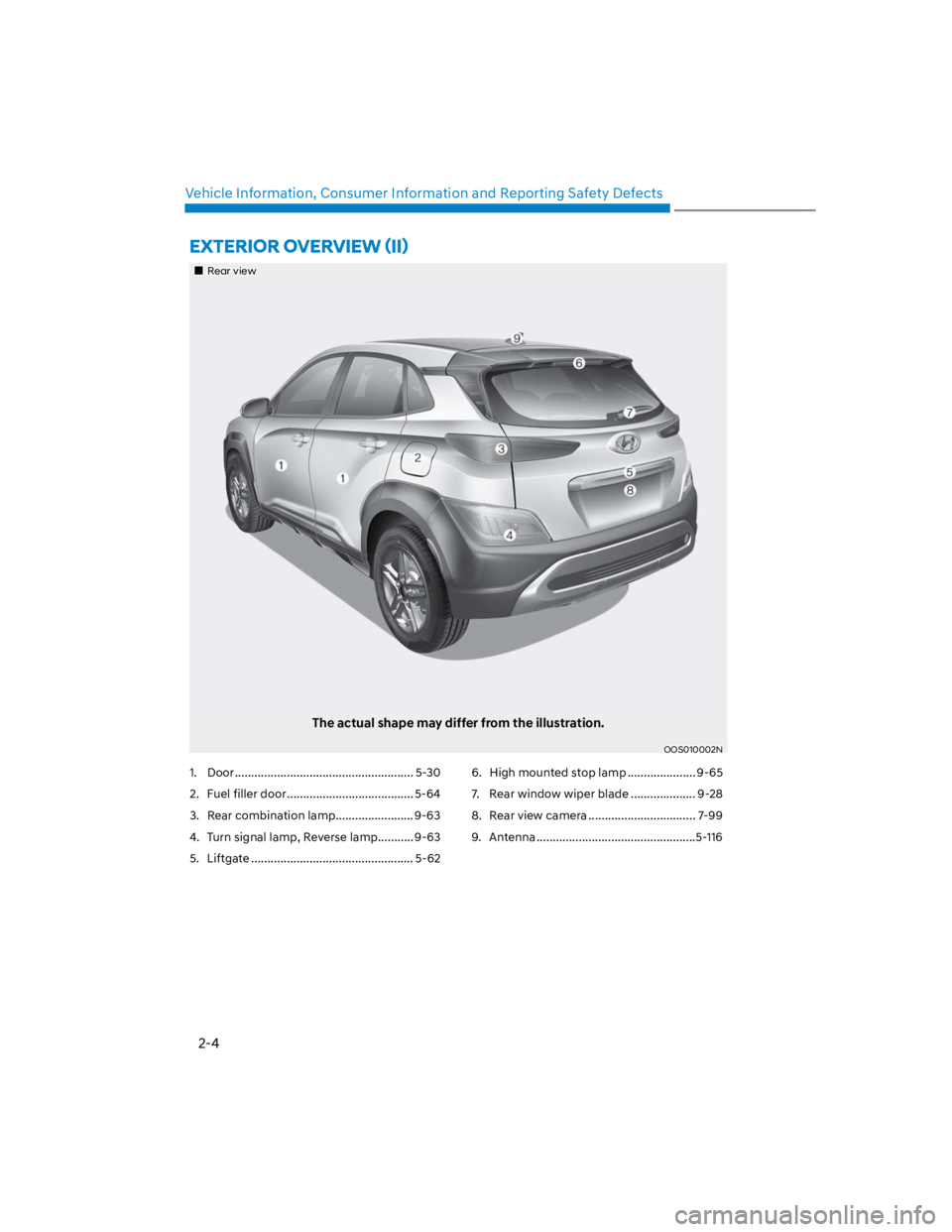
2-4
Vehicle Information, Consumer Information and Reporting Safety Defects
1. Door ....................................................... 5-30
2. Fuel filler door ....................................... 5-64
3. Rear combination lamp........................ 9-63
4. Turn signal lamp, Reverse lamp ........... 9-63
5. Liftgate .................................................. 5-62
6. High mounted stop lamp ..................... 9-65
7. Rear window wiper blade .................... 9-28
8. Rear view camera ................................. 7-99
9. Antenna .................................................5-116
Rear view
The actual shape may differ from the illustration.
OOS010002N
Page 18 of 579
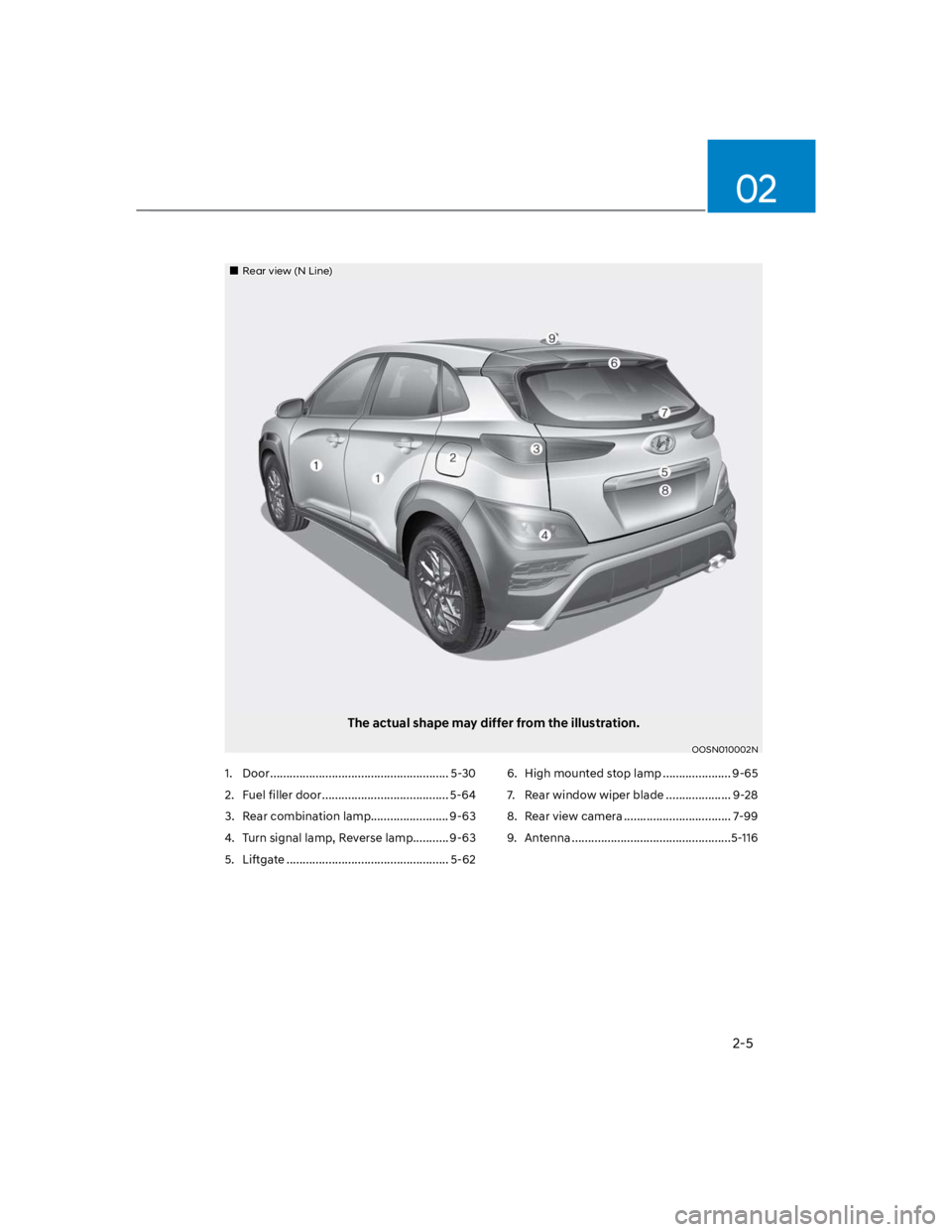
2-5
02
1. Door ....................................................... 5-30
2. Fuel filler door ....................................... 5-64
3. Rear combination lamp........................ 9-63
4. Turn signal lamp, Reverse lamp ........... 9-63
5. Liftgate .................................................. 5-62
6. High mounted stop lamp ..................... 9-65
7. Rear window wiper blade .................... 9-28
8. Rear view camera ................................. 7-99
9. Antenna .................................................5-116
Rear view (N Line)
The actual shape may differ from the illustration.
OOSN010002N
Page 20 of 579
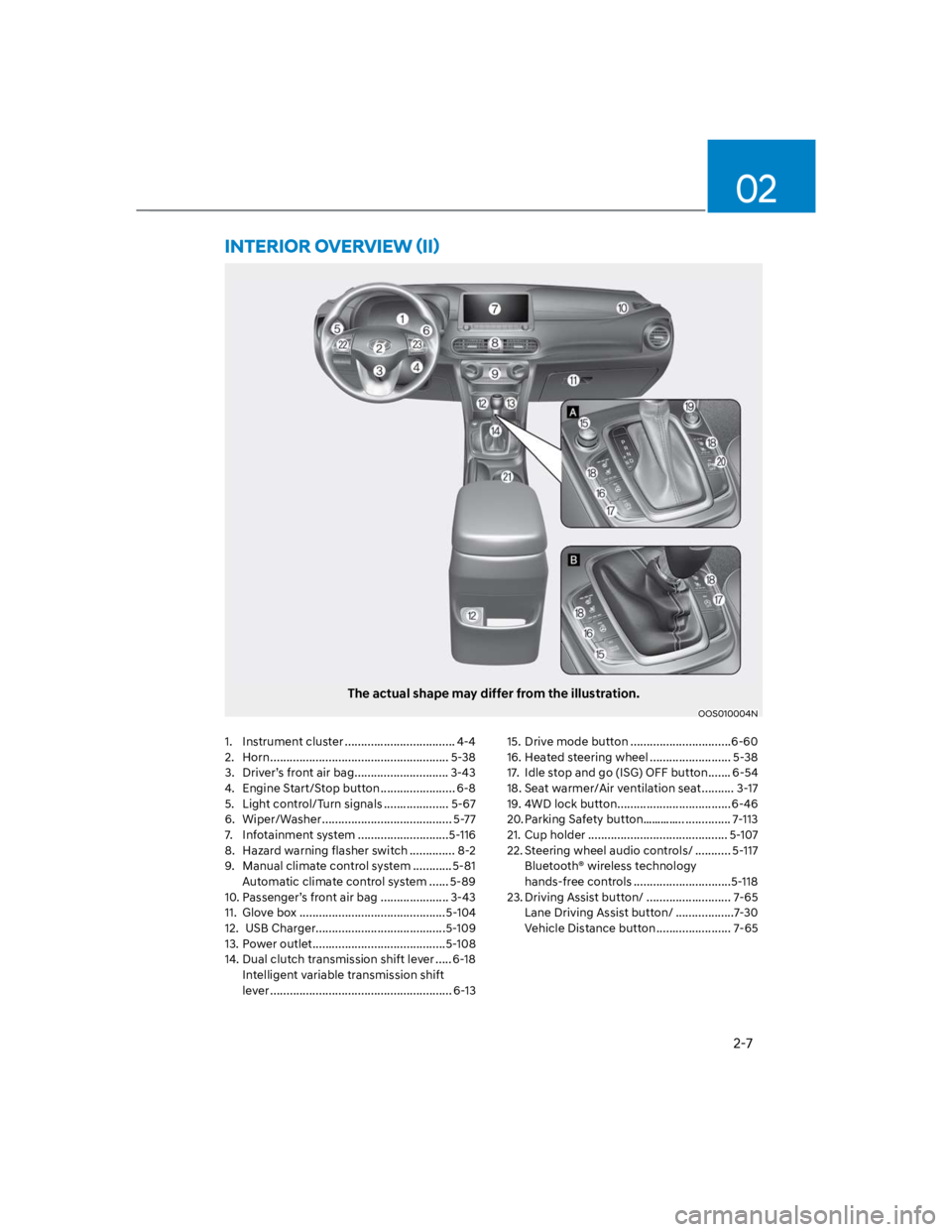
2-7
02
The actual shape may differ from the illustration.
OOS010004N
1. Instrument cluster .................................. 4-4
2. Horn ....................................................... 5-38
3. Driver’s front air bag ............................. 3-43
4. Engine Start/Stop button ....................... 6-8
5. Light control/Turn signals .................... 5-67
6. Wiper/Washer ........................................ 5-77
7. Infotainment system ............................5-116
8. Hazard warning flasher switch .............. 8-2
9. Manual climate control system ............5-81
Automatic climate control system ...... 5-89
10. Passenger’s front air bag ..................... 3-43
11. Glove box .............................................5-104
12. USB Charger........................................5-109
13. Power outlet .........................................5-108
14. Dual clutch transmission shift lever ..... 6-18
Intelligent variable transmission shift
lever ........................................................ 6-13
15. Drive mode button ...............................6-60
16. Heated steering wheel ......................... 5-38
17. Idle stop and go (ISG) OFF button ....... 6-54
18. Seat warmer/Air ventilation seat .......... 3-17
19. 4WD lock button ...................................6-46
20. Parking Safety button………….. .............. 7-113
21. Cup holder ........................................... 5-107
22. Steering wheel audio controls/ ........... 5-117
Bluetooth® wireless technology
hands-free controls ..............................5-118
23. Driving Assist button/ .......................... 7-65
Lane Driving Assist button/ ..................7-30
Vehicle Distance button ....................... 7-65
Page 23 of 579

Vehicle Information, Consumer Information and Reporting Safety Defects
2-10
Light Bulb Bulb Type Wattage
Front
Headlamp
Low (Type A) 9005HL+ 60W
High (Type A) 9005HL+ 60W
Low (Type B) LED LED
High (Type B) LED LED
Turn signal lamp P28/8W 28W
Side marker LED LED
Turn signal lamp (Outside mirror) LED LED
Daytime running lamp (DRL) /
position lampLED LED
Fog lamp HB4 55W
Rear
Rear combination
lamp
Stop/Tail
(Type A)P21/5WSTOP : 21,
TAIL : 5
Tail (Type A) W5W 5W
Stop/Tail
(Type B)LED LED
Turn signalTYPE A:PY21W,
TYPE B:LED
TYPE A:21W,
TYPE B:LED
Reverse lamp P21W 21
Fog lamp PR21W 21
High mounted stop lamp LED LED
Side markerTYPE A:W5W,
TYPE B:LED
TYPE A:5W,
TYPE B:LED
License plate lamp W5W 5
Interior
Map lamp W10W 10
Room lamp (with sunroof) FESTOON 8
Room lamp (without sunroof) FESTOON 10
Sunvisor lamp FESTOON 5
Tailgate room lamp FESTOON 10
Glove box lamp FESTOON 5
BULB WATTAGE
Page 78 of 579

03
3-47
During a moderate to severe frontal
collision, sensors will detect the
vehicle’s rapid deceleration. If the rate of
deceleration is high enough, the control
unit will inflate the front air bags, at the
time and with the force needed.
The front air bags help protect the driver
and front passenger by responding to
frontal impacts in which seat belts alone
cannot provide adequate restraint. When
needed, the side air bags help provide
protection in the event of a side impact
or rollover by supporting the side upper
body area.
Air bags are activated (able to
inflate if necessary) only when the
Engine Start/Stop button is in the
ON or START position, and it can be
activated within about 3 minutes after
the engine is turned off.
Air bags inflate in the event of certain
frontal or side collisions to help
protect the occupants from serious
physical injury.
There is no single speed at which the
air bags will inflate. Generally, air bags
are designed to inflate based upon the
severity of a collision and its direction.
These two factors determine whether
the sensors produce an electronic
deployment/inflation signal.
The front air bags will completely
inflate and deflate in an instant. It is
virtually impossible for you to see the
air bags inflate during an accident. It is
much more likely that you will simply
see the deflated air bags hanging out
of their storage compartments after
the collision.
In addition to inflating in serious side
collisions, vehicles equipped with a
rollover sensor, side and/or curtain air
bags will inflate if the sensing system
detects a rollover.
When a rollover is detected, curtain
air bags will remain inflated longer to
help provide protection from ejection,
especially when used in conjunction
with the seat belts. (if equipped with a
rollover sensor)
To help provide protection, the air
bags must inflate rapidly. The speed
of air bag inflation is a consequence
of extremely short time in which
to inflate the air bag between the
occupant and the vehicle structures
before the occupant impacts those
structures. This speed of inflation
reduces the risk of serious or
lifethreatening injuries and is thus a
necessary part of air bag design.
However, the rapid air bag inflation
can also cause injuries which can
include facial abrasions, bruises and
broken bones because the inflation
speed also causes the air bags to
expand with a great deal of force.
There are even circumstances under
which contact with the air bag can
cause fatal injuries, especially if the
occupant is positioned excessively
close to the air bag.
You can take steps to reduce the risk
of being injured by an inflating air bag.
The greatest risk is sitting too close to
the air bag. An air bag needs about 10
in. (25 cm) of space to inflate. NHTSA
recommends that drivers allow at least
10 in. (25 cm) between the center of the
steering wheel and the chest.
Page 95 of 579

4
Turn signal indicator light ........................................................................................4-20
High beam indicator light .......................................................................................4-20
High Beam Assist indicator light ..............................................................................4-21
Cruise Indicator Light ...............................................................................................4-21
SPORT Mode Indicator Light ....................................................................................4-21
SMART Mode Indicator Light ...................................................................................4-21
Master warning light .................................................................................................4-21
LCD display messages ............................................................................................... 4-22
Shift to P (for smart key system and dual clutch transmission)............................ 4-22
Low key battery (for smart key system).................................................................. 4-22
Press START button while turning wheel (for smart key system) ......................... 4-22
Steering wheel not locked (for smart key system) ................................................ 4-22
Press brake pedal to start engine (for smart key system and dual clutch
transmission) ........................................................................................................... 4-22
Key not in vehicle (for smart key system) ............................................................... 4-22
Key not detected (for smart key system)................................................................ 4-22
Press START button again (for smart key system) ................................................ 4-22
Press START button with key (for smart key system) ........................................... 4-23
Check BRAKE SWITCH fuse (for smart key system and dual clutch
transmission) ........................................................................................................... 4-23
Shift to P or N to start engine (for smart key system and dual clutch
transmission) ........................................................................................................... 4-23
Battery discharging due to external electrical devices ......................................... 4-23
Door, Hood, Liftgate open indicator .......................................................................4-24
Sunroof open indicator ............................................................................................4-24
Low tire pressure .....................................................................................................4-24
Lights ........................................................................................................................ 4-25
Wiper ........................................................................................................................ 4-25
Heated Steering Wheel turned off .......................................................................... 4-25
Low washer fluid ...................................................................................................... 4-25
Low fuel .................................................................................................................... 4-25
Engine overheated / Engine has overheated .........................................................4-26
Check exhaust system .............................................................................................4-26
Check headlight .......................................................................................................4-26
Check turn signal .....................................................................................................4-26
Check headlamp LED ..............................................................................................4-26
Check Forward Safety system ................................................................................. 4-27
Check Lane Keeping Assist (LKA) system .............................................................. 4-27
Check Blind-Spot Safety system............................................................................. 4-27
Check Driver Attention Warning system ................................................................ 4-27
Check High Beam Assist (HBA) system .................................................................. 4-27
Check Smart Cruise Control system ....................................................................... 4-27